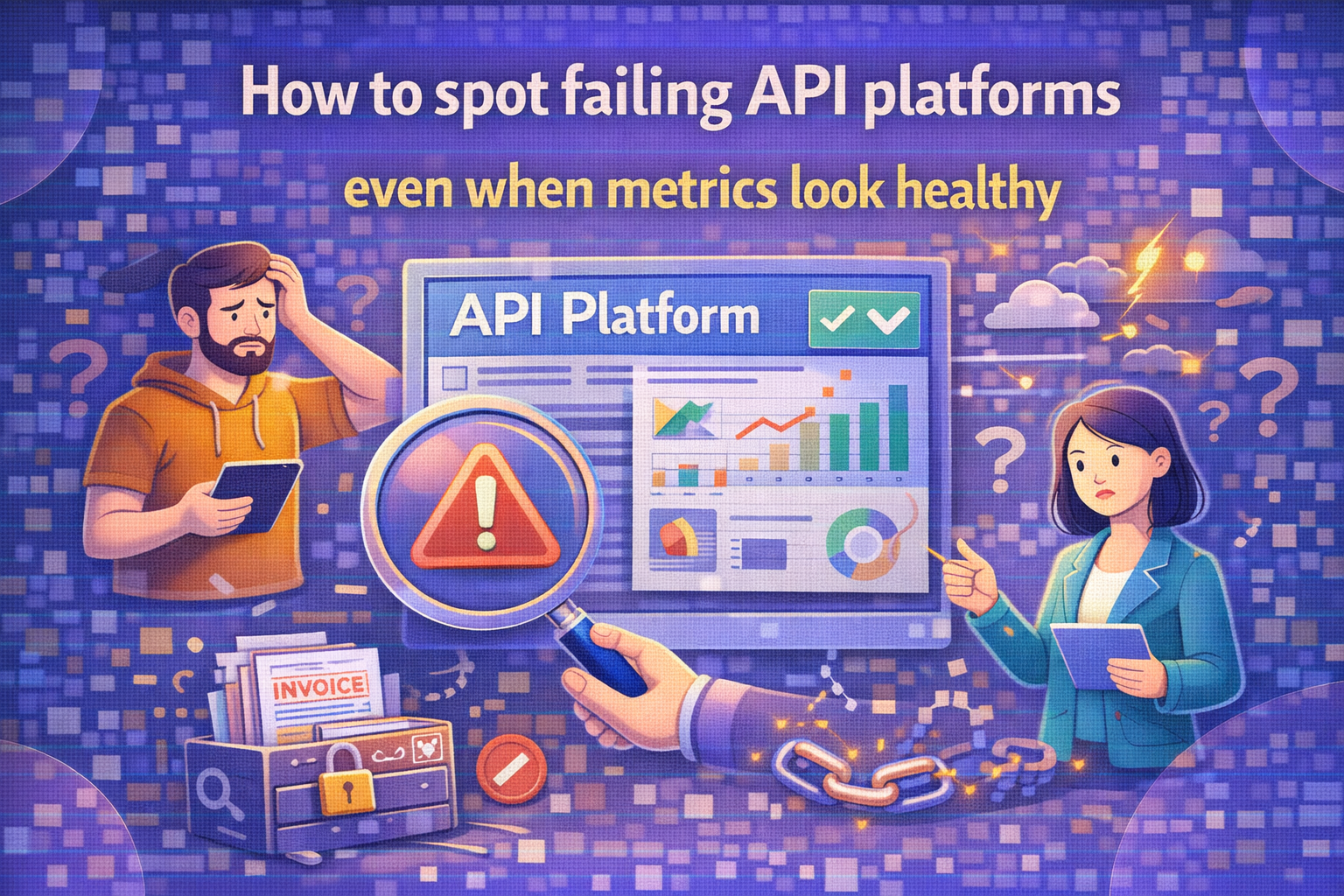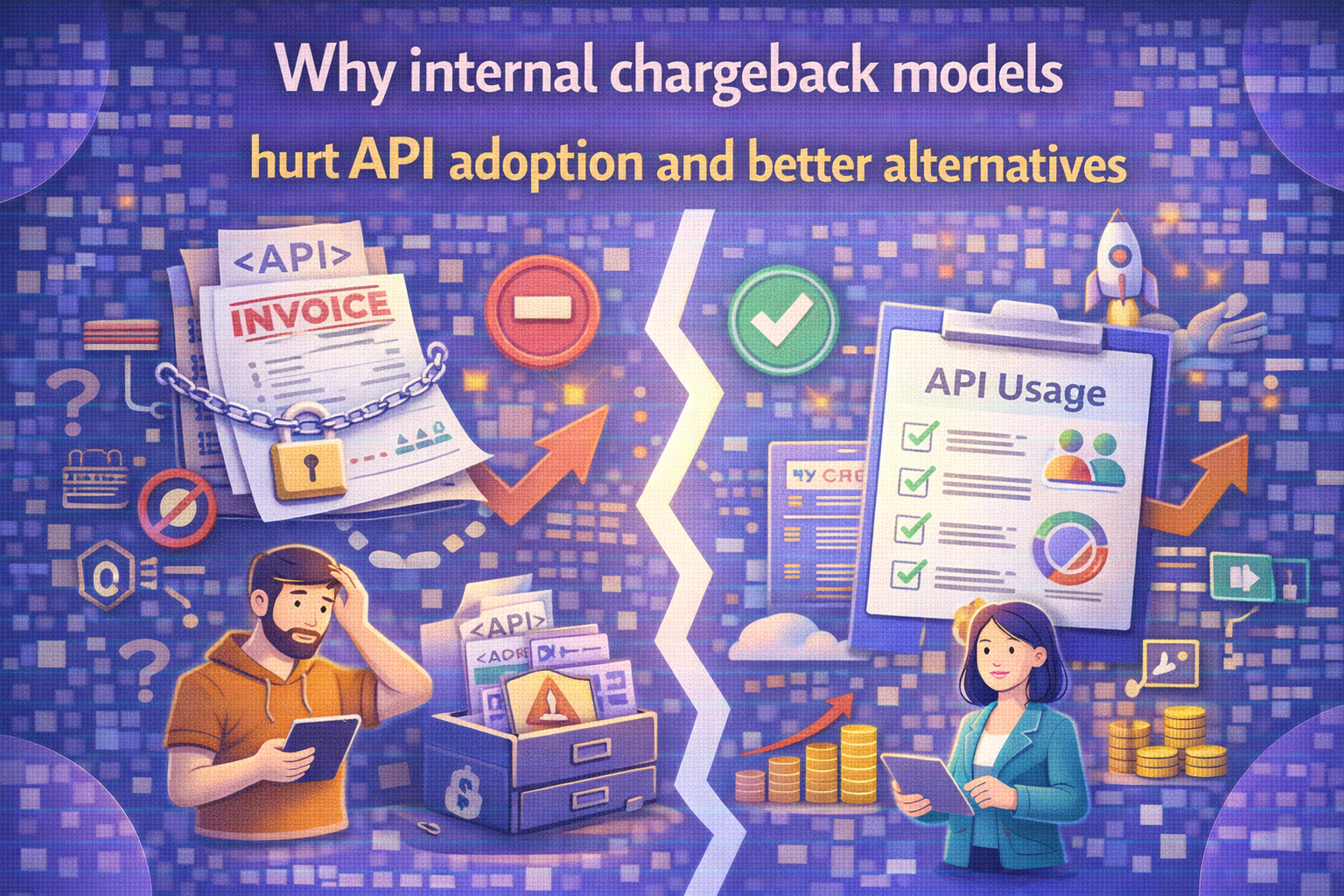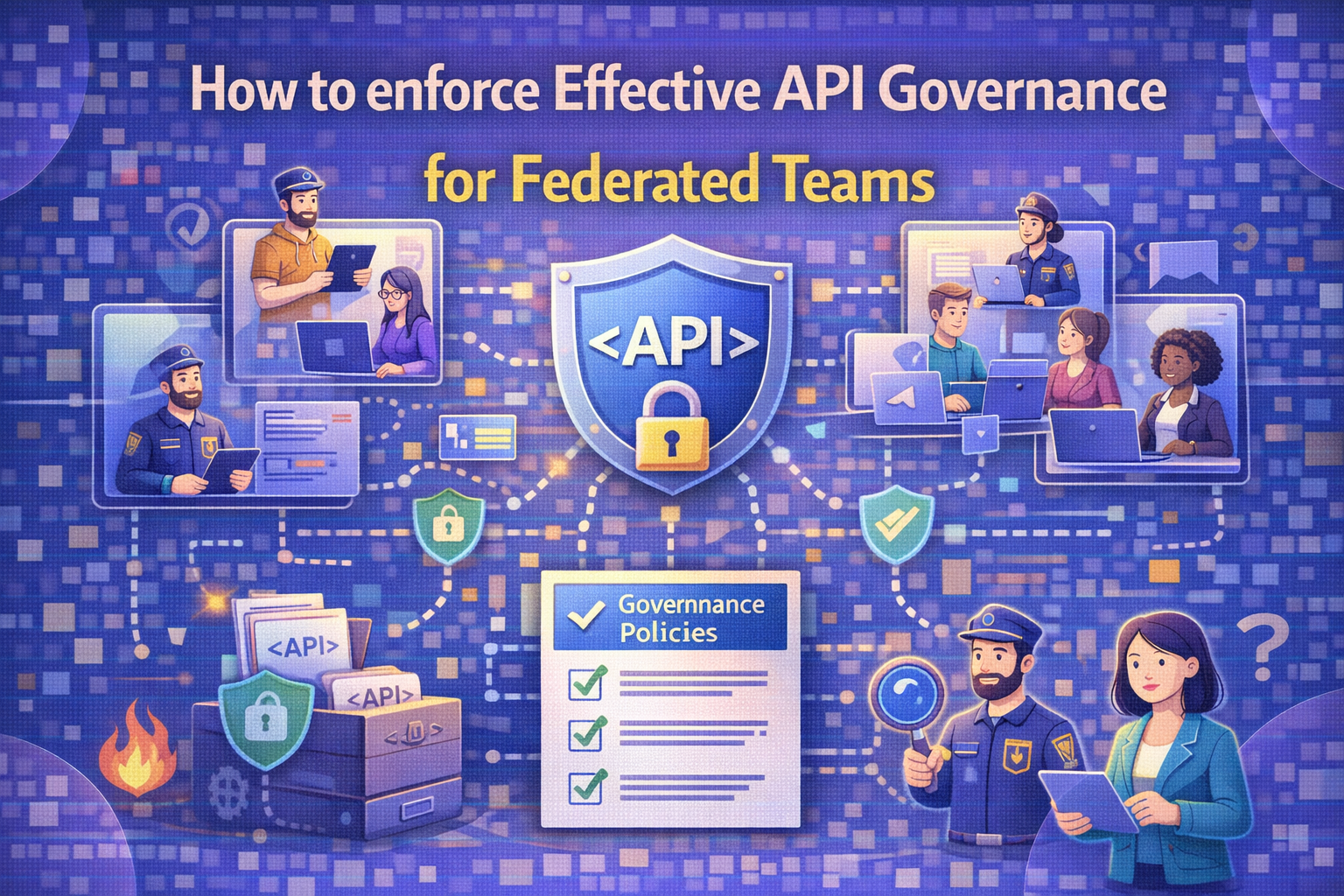
APIs today are no longer just endpoints; they’re gateways for AI agents that need context, intent, and rules to interact safely and effectively. Making your APIs MCP‑ready means enhancing them with clear specifications, semantic descriptions, guardrails, and observability, so they’re discoverable, secure, and agent-friendly.
DigitalAPI makes this effortless: enrich your APIs, add MCP metadata, and get them agent-ready in under a minute without rebuilding from scratch.
Ready to make your APIs MCP-ready? Book a demo today and see how DigitalAPI simplifies the process.
APIs aren’t just powering apps anymore, by 2027, 85% of AI-driven applications will rely on real-time API integrations, making APIs the critical decision endpoints for autonomous AI agents. Most, however, were built for humans: tribal knowledge, loose docs, manual judgement.
Model Context Protocol (MCP) fixes this by encoding how, why and when an API should be used so LLMs can call it safely, making APIs truly “agent-ready.” You don’t need to rewrite anything; wrap existing APIs with the right metadata, controls and semantics. This blog shows how how you can make your APIs MCP ready
What is MCP, and why does it matter?
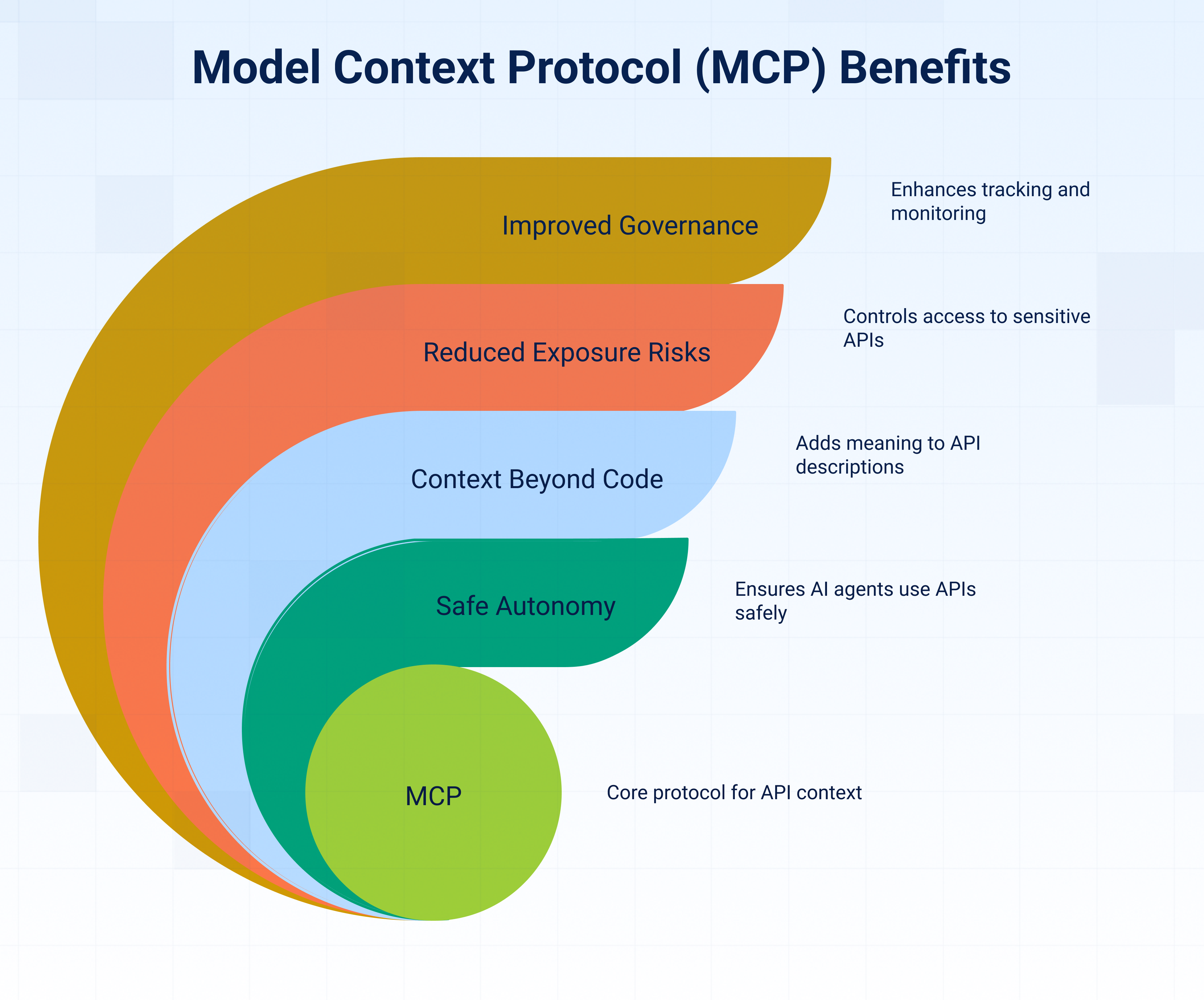
Model Context Protocol (MCP) is a structured way to describe the operational context of an API, beyond what OpenAPI or Swagger provides. It enables machines, especially AI agents, to understand when, why, and how to use an API. MCP wraps existing APIs with additional semantic, behavioural, and access metadata so agents can reason about them without human help.
It’s not a replacement for OpenAPI. Instead, it extends the contract, covering intent, ownership, usage constraints, fallback logic, and more. Think of it as giving APIs a brain and a rulebook that agents can interpret safely and autonomously. Let’s take a look at why it has become so important so quickly.
- Enables safe autonomy for AI agents: AI agents don’t rely on UI buttons or developer notes. MCP allows them to discover and invoke APIs based on structured logic, ensuring they don’t misuse endpoints or trigger unintended actions.
- Adds context beyond code: Traditional specs only describe syntax. MCP adds meaning, like when to use a refund API versus a cancellation API, so agents can make informed choices aligned with business logic.
- Reduces overexposure risks: With fine-grained metadata and access controls, MCP lets teams expose APIs safely to agents without opening up sensitive or unstable endpoints to uncontrolled automation.
- Improves governance and auditing: MCP-ready APIs are easier to track, monitor, and govern. Invocation trails show not just who called the API, but which agent did it, under what context, and with what outcome.
- Accelerates internal developer experience: MCP tagging improves discoverability inside service catalogues. Engineers can find the “right” API faster, complete with usage policies and prompts that reduce onboarding friction.
- Future-proofs your API estate: As agent-based orchestration grows, MCP-readiness will become a baseline expectation. Wrapping your APIs now ensures long-term adaptability with minimal rework.
- Brings APIs closer to products: MCP helps package APIs not just as technical contracts, but as intelligent, self-explanatory products ready to be consumed by apps, partners, and AI alike.
Pre-requisites to make your APIs MCP ready
Before you can make your APIs MCP-ready, your foundational hygiene needs to be in place. This doesn’t mean rebuilding your APIs—it means making sure the specs, metadata, and controls are consistent, complete, and machine-readable. Think of this as laying the groundwork before layering on MCP semantics.
Checklist for MCP readiness
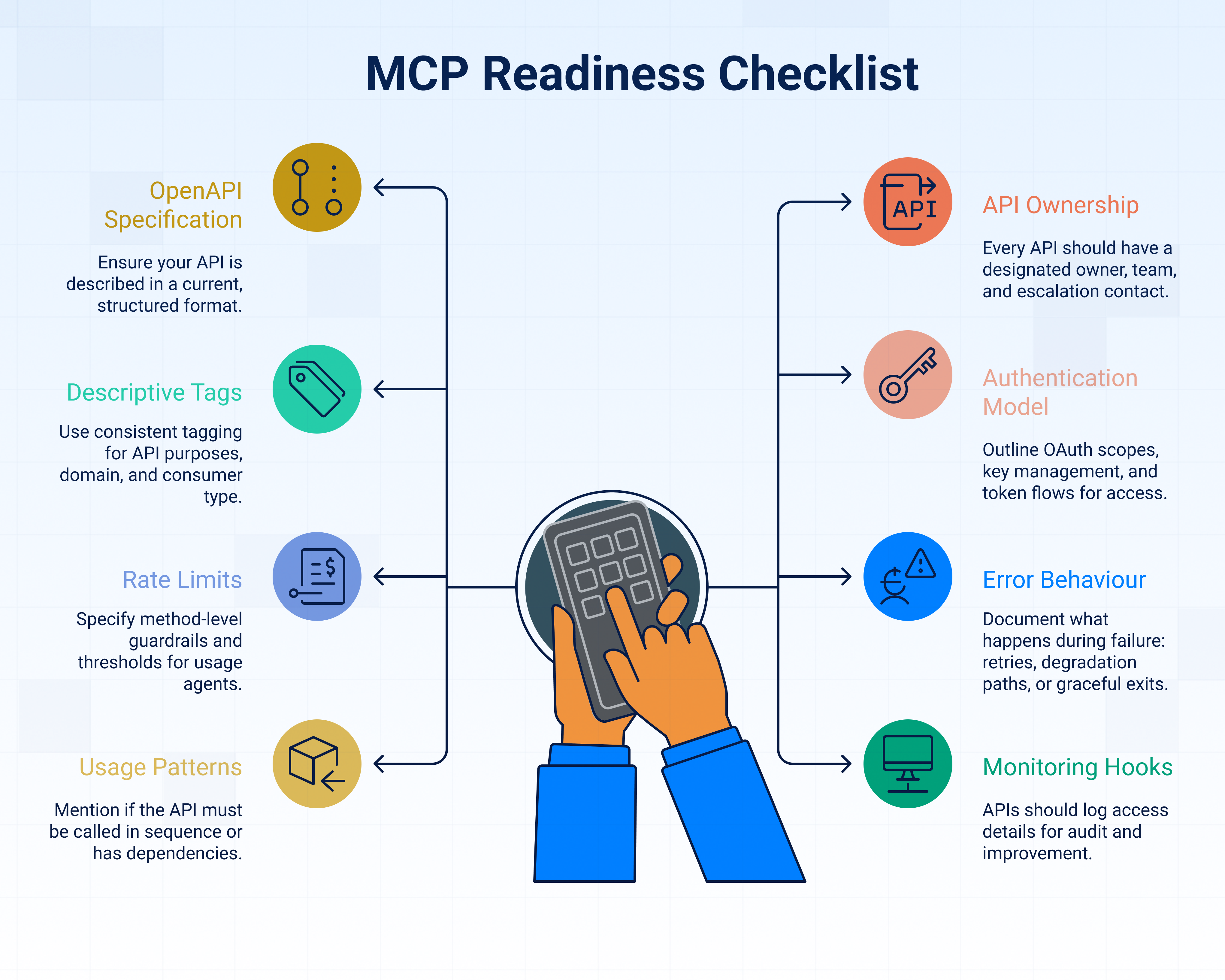
- OpenAPI 3.1+ specification available: Ensure your API is described in a current, structured format with components, examples, and schema references.
- Clear API ownership and contact defined: Every API should have a designated owner, team, and escalation contact, with metadata that agents can inherit for governance.
- Descriptive tags and domain classification: Use consistent tagging for API purposes, domain (e.g., payments, identity), and consumer type (internal, partner, public).
- Authentication and permission model documented: Outline OAuth scopes, key management, and token flows so agents know how to gain access appropriately.
- Rate limits and method constraints defined: Specify method-level guardrails and thresholds for usage agents must know what's safe and what isn't.
- Fallback and error behaviour described: Document what happens during failure: retries, degradation paths, or graceful exits.
- Usage patterns and dependencies documented: Mention if the API must be called in sequence, requires another service to be up, or depends on data freshness.
- Monitoring and observability hooks in place: APIs should log who accessed them (agent or user), how, and what result was returned, critical for audit and improvement.

How to make your APIs MCP-ready: Step-by-step guide
Converting APIs to be MCP-ready is less about reinventing the API and more about enriching it with context, constraints, and clarity, so agents can reason about it without human supervision. Here are the detailed steps to fully wrap your APIs with MCP-compliant metadata and semantics.
1. Standardise the API specification
Start by cleaning and upgrading your API spec to OpenAPI 3.1 or later. This version allows for better schema definitions, $ref resolution, and support for newer data types. Remove any undocumented parameters, deprecated endpoints, or placeholder fields. Validate schemas against real payloads and ensure your request/response examples are accurate. Well-formed specs are the foundation on which all MCP metadata will be layered.
2. Enrich the API with domain-specific metadata
MCP relies on rich, structured metadata that agents can interpret to understand what an API does and why it matters. For each API, include:
- Business domain (e.g. Payments, Lending, Support)
- Purpose (e.g. InitiateTransaction, FetchLoanStatus)
- Visibility (internal, partner, public)
- Ownership (team, squad, contact person)
- Consumer types (humans, agents, apps)
- Risk profile (low, medium, high)
This metadata helps agents and internal tools automatically rank, group, and surface the right APIs for a given task.
3. Embed semantic descriptions in the schema
Agents don’t just need to read field names; they need to understand the meaning. Use semantic annotations or schema extensions to explain the role of each parameter:
- Describe what each input and output field represents
- Define relationships between fields (e.g., "expiry_date" must be after "issue_date")
- Include constraints that are not captured in type definitions (e.g., "amount" must be non-zero and in USD)
These annotations can be added as comments or custom extensions (x-field-desc, x-relationships, etc.), depending on your tooling. This step is what makes the API machine-reasonable, not just machine-readable.
4. Define invocation constraints and guardrails
MCP-ready APIs must be safe for autonomous invocation. Define guardrails that tell an agent:
- What methods are supported (GET, POST, etc)
- Whether the operation is idempotent
- How to handle timeouts, retries, or throttling
- What preconditions must be met (e.g., a user must exist before calling this)
- Which error codes require escalation or fallback
For example, if an API for “block card” can only be called once per card within 5 minutes, that logic must be encoded as metadata. Agents will use this information to avoid unsafe loops or redundant calls.
5. Attach dynamic access control policies
Agents must not invoke sensitive APIs unless they’re explicitly authorised. Define and document:
- Required OAuth scopes
- Role-based access controls (e.g., "role": "agent.fraud-ops")
- Attribute-based conditions (e.g., internal agents can only invoke after 6 PM, or only on staging)
Map access controls clearly in your spec or service config. If using an API gateway like Apigee or AWS, these can often be defined declaratively and exposed via annotations or policy templates.
6. Instrument observability for agent activity
Autonomous access requires accountability. Every MCP-ready API should include:
- Agent identity logging (agent ID, org, prompt ID)
- Invocation timestamps and execution metadata
- Outcome (success, error, timeout)
- Anomaly detection hooks (e.g., flag if the same prompt calls the same endpoint repeatedly)
This data should be piped into dashboards and alerting systems, separate from human API usage to track agent behaviour, detect misuse, and support compliance audits.
7. Generate natural language prompts and summaries
While metadata helps with logic, agents often rely on language models to understand and compare API choices. Add brief, natural language summaries like:
“This API initiates a loan pre-approval check for salaried customers. Use only after verifying customer identity and employment status.”
These summaries can be stored as x-description, x-agent-note, or in a parallel agent-facing catalogue. They boost compatibility with agent frameworks and LLM-based agents that rely on embeddings or retrieval-augmented prompts.
8. Register and version in an MCP-compatible catalogue
Finally, publish your API into a catalogue that supports MCP-compliant metadata, such as DAC’s Service Hub or an internal developer portal. Group APIs by domain, agent compatibility, and security profile. Ensure:
- MCP versions are tracked separately from legacy specs
- Search filters can include agent-compatibility and use-case tags
- Updates to context metadata trigger alerts or reviews
This ensures discoverability, governance, and reusability in agent-driven workflows.
Convert your APIs to MCP in one click with Digital API
When you have thousands of APIs, converting each of them to MCP can be time-consuming and expensive. But what if it didn’t have to be a manual effort? Sounds amazing, right? Well, with DigitalAPI’s service hub, you can select any API in your library and convert it to an MCP with one click in less than a minute.
At the same time, these APIs will be ready to be used by API-GPT, our AI agent built on your APIs. It will allow you to perform any task, fetch information, automate actions, and much more with a simple natural language prompt.
FAQs
1. What does MCP-ready mean?
MCP-ready means an API has been wrapped with structured context, metadata, access controls, and semantic descriptions so that AI agents can understand, reason about, and safely invoke it autonomously. It goes beyond syntax to describe the API’s purpose, constraints, and usage patterns, enabling trustworthy and predictable behaviour in machine-driven environments.
2. How is MCP different from OpenAPI?
OpenAPI defines how an API works, including endpoints, methods, and parameters. MCP extends this by describing when, why, and under what rules an API should be used. It includes context, ownership, guardrails, access policies, and machine-readable summaries. In short, OpenAPI helps developers; MCP enables autonomous agents to interact with APIs safely and intelligently.
3. Do all APIs need to be MCP-ready?
No, not all APIs need to be MCP-ready. MCP readiness is most valuable for APIs that are likely to be accessed by AI agents or used in automated decision-making. Internal system APIs, legacy integrations, or unstable endpoints may not require MCP wrapping unless they're being exposed for intelligent orchestration or autonomous execution.
4. How do I secure MCP-ready APIs?
Secure MCP-ready APIs using dynamic access control: define OAuth scopes, role-based or attribute-based permissions, and usage constraints like rate limits or time-based rules. Also, tag sensitive APIs, restrict agent-level access by context, and log every invocation with agent identity and prompt traceability. Governance should be baked into the API contract, not bolted on.
5. Can legacy APIs be converted to MCP?
Yes, legacy APIs can be made MCP-ready by adding an external metadata layer without rewriting the API itself. This involves creating or updating the OpenAPI spec, layering semantic context, defining invocation rules, and wrapping it with governance policies. The original API logic remains intact, while the agent-facing interface gains clarity and control.
You’ve spent years battling your API problem. Give us 60 minutes to show you the solution.
.svg)

%20(1).png)

